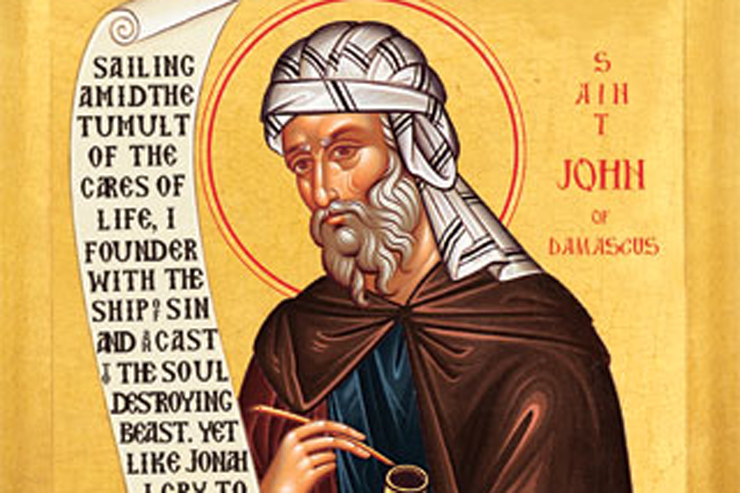 Happy St John Damascene day!
Happy St John Damascene day!I don't know if it is by accident or design that he is celebrated during Advent, but he is one of the great defenders of the Incarnation.
I thought I would have fun this morning, w3e had a class of 9/10 year olds in for Mass this morning, so I tried explaining iconoclasm and iconophilia to them.

St John of course was a resident of Damascus, in Syria which until 636 had been a Christian city, John was born 10 years after it conquest by Islam. It is worth noting that the Koran says more about Jesus than Mohamed, it is Jesus, not Mohamed who will come as judge at the end of time. Islam denies the idea that God could ever become Man and could suffer and die on the cross.
St John saw Islam as being a Christian heresy, a re-capitulation and extension of Arianism, which ends up by denying God's ability to transcend himself and become one with his creation. The doctrines of the Trinity and Incarnation affirm God becomes one with us, he descends to us, becoming Man, and raises us up so the we might become Divinised. For Islam at best man may become a servant or slave of God, but never a Son.
Iconoclasm is more than denying that God can be portrayed, on its simplest level it is about the destruction of icons but underlying that thought is a dis-ease with the notion that God can become one with us, that he can be seen in flesh and blood, the next stage of course is to deny that Holy Eucharist or the Sacraments can be a meeting with the Divine, and beyond that, that we cannot encounter sanctifying Grace.
 |
| A RE-ORDERING AT JOSEPHIUM , OHIO |
More than that, it has lead to the profanation of the Sacred Liturgy, to reducing the sacraments to something self referential, to seeing the Church as something quite human rather than of Divine origin and end, and of God's presence in the world. It sees the priesthood and episcopate as mere jobs that even someone in serious sin can do.
 In
many ways the Extra-ordinary Synod on the Family was a battle between
iconoclasts and iconophiles, those who believe marriage is an image of
the unbreakable union of Christ and his Church and those who don't.
In
many ways the Extra-ordinary Synod on the Family was a battle between
iconoclasts and iconophiles, those who believe marriage is an image of
the unbreakable union of Christ and his Church and those who don't.There is an iconophile mindset that always wants to see the image of God and experience his presence, just as there is an iconoclastic mindset wants to move away from God and to shut him out. Iconoclasm is dangerous. |Euthanasia and abortion become so easy if we do not see in the vulnerable the image of God.
I am concerned by a iconoclastic mindset in the Church, not only does it 'wreckovate buildings' but it excludes images of Christ and ultimately the person of Christ from the Church's life, I was given some posters recently to be distributed advertising a Catholic event, lots of pictures of bishops, none of Christ: that is an iconoclastic mindset.
[Hat tip to Sir A.S.]

No comments:
Post a Comment